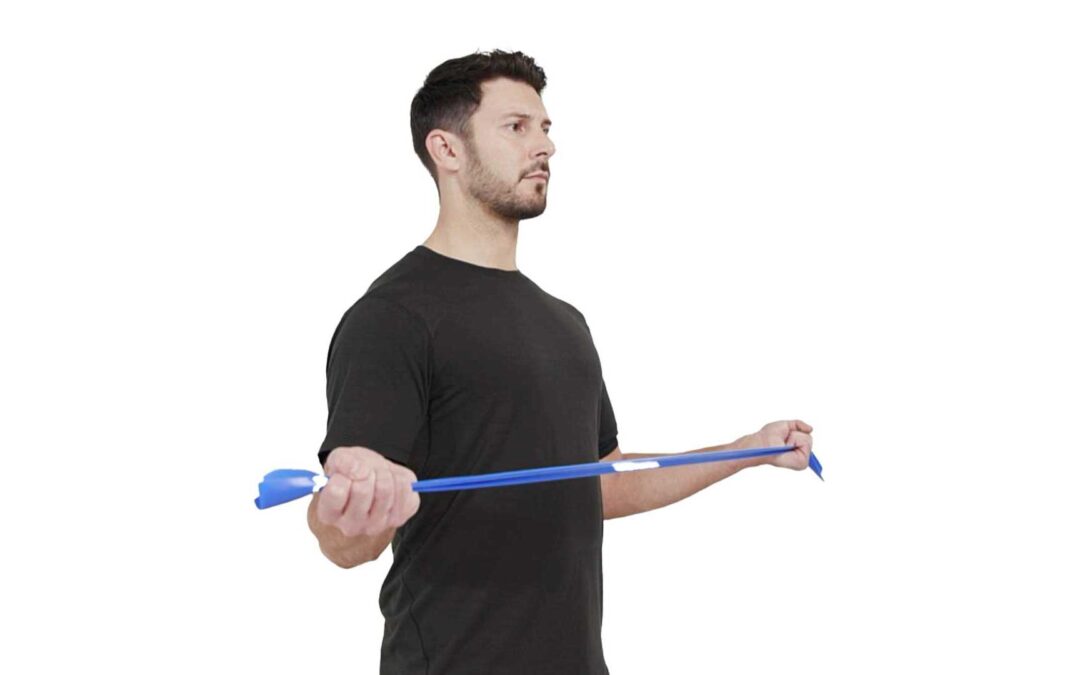What is Banded External Rotation?
Banded external rotation is a resistance training exercise that targets the shoulders and rotator cuff muscles. It involves standing with a resistance band at shoulder height, bending at the hips and disposing of one arm directly downward, while keeping the other arm at shoulder height and rotating it across the front of the body. This exercise can increase strength, stability, and mobility in the shoulders and rotator cuff. It’s also a great way to prevent injuries and alleviate pain caused by imbalances in the shoulder joint.
Benefits and Indications of Banded External Rotation
Banded external rotation is a physiotherapy exercise that targets the rotator cuff muscles, particularly the infraspinatus, a critical muscle for stabilizing the shoulder joint. This exercise can be used as a part of prehabilitation, rehabilitation, and performance enhancement programs. Banded external rotation can be beneficial for various shoulder injuries, such as rotator cuff tendinopathy, labral tears, and frozen shoulder. It can improve the strength and endurance of the rotator cuff muscles, reduce pain and inflammation, and enhance neuromuscular control. Moreover, banded external rotation can enhance shoulder mobility and prevent future injuries.
How to Perform Banded External Rotation
To perform banded external rotation, you’ll need a resistance band that you can tie to a door handle or any other stable object. Here are the steps to follow:
- Stand up and place the resistance band on both wrists.
- Bend your elbows to make a 90-degree angle, and move them apart a bit until you feel a slight tension.
- Turn your wrists so that your thumbs are pointing outwards.
- Relax your neck and shoulders by gently pulling your shoulder blades down towards your waist.
- Slowly move your forearms apart while keeping your elbows close to your sides.
- Pause at the end of each movement before slowly bringing your forearms back together.
- Keep your shoulder blades squeezed down and in to prevent your shoulders from lifting.
- Focus on keeping your elbows tucked in by your sides throughout the exercise.
- Make sure your wrists stay in line with your forearms as you move the band apart.
- Remember not to hold your breath during the exercise.
- Only go as far as comfortable and as advised by your physiotherapist, especially if you feel any pain.
It’s important to maintain proper technique and form during the exercise. Also, avoid shrugging your shoulder or compensating with other muscles. Breathe deeply during the exercise, inhaling before you rotate your arm and exhaling slowly as you return to the starting position.
Variations and Progressions of Banded External Rotation
Once you’ve mastered the basic banded external rotation, you can progress to more challenging variations and progressions. Here are a few examples:
- Seated banded external rotation: Sit on a bench or chair with your back straight and your feet on the ground. Hold the resistance band with your injured arm and perform the external rotation as described above. This variation can challenge your core stability and balance.
- Standing banded external rotation: Stand with your feet shoulder-width apart and your knees slightly bent. Hold the resistance band with your injured arm and perform the external rotation as described above. This variation can challenge your hip and ankle stability.
- Banded external rotation with eccentric control: Slowly lower your arm to the starting position, taking 3-5 seconds to complete the movement. This variation can enhance your eccentric strength and control.
- Banded external rotation with isometric hold: Hold the end position of the external rotation for 3-5 seconds, maintaining your shoulder blade retracted and your elbow at your side. This variation can enhance your isometric strength and endurance.
It’s essential to progress or regress the exercise based on your individual response and feedback. Consult with a physiotherapist to determine the most appropriate variation and progression for your specific needs.
Tips for Choosing the Right Resistance Band and Proper Warm-up
To choose the right resistance band for your needs, consider your fitness level, injury severity, and exercise goals. The resistance band should provide enough tension to challenge your muscles without causing pain or discomfort. Additionally, it’s important to warm up properly before performing banded external rotation or any other exercise. A proper warm-up can increase blood flow, reduce muscle stiffness, and enhance joint mobility. Consider incorporating exercises such as arm circles, wall angels, and scapular retractions in your warm-up routine.
Using a Physiotherapy App to Monitor Progress
To optimize your shoulder training and recovery, you can use a physiotherapy app to monitor progress, track exercise adherence and recovery, and communicate with a physiotherapist remotely. Some of the popular physiotherapy apps include Physitrack, PT Momentum, and Physiotherapy Exercises. These apps provide features such as an exercise library, video demonstrations, progress tracking, and messaging. Make sure to use a reliable and secure app that complies with the relevant data protection and ethical standards.
Merlin Physio for Shoulder Injury
Shoulder injuries can be a real pain, quite literally. But fear not, because there’s a magical solution in the form of the Merlin Physio app. This app is like a trusty sidekick for physiotherapists and clinics, making the journey to recovery smoother and more efficient.
Imagine having all your patient’s progress right at your fingertips. With Merlin Physio, physiotherapists can easily track their patient’s recovery journey. No more shuffling through piles of paperwork or struggling to find the right file. Everything you need is neatly organized in this app, making it a breeze to monitor how your patient’s shoulder is healing.
Recording patient details has never been simpler. Merlin Physio lets you save all the important information you need. From their medical history to their treatment plan, it’s all securely stored in one place. This not only saves time but also reduces the chances of errors. You won’t have to worry about missing crucial details or wasting time on unnecessary delays.
Conclusion
Banded external rotation is a simple yet effective exercise that can significantly enhance the recovery process of shoulder injuries. By understanding its benefits, variations, and progressions, you can incorporate banded external rotation into your shoulder rehabilitation program and achieve your fitness goals. Remember to consult with a physiotherapist before starting any new exercise program and progress or regress the exercise based on your individual response and feedback. With the right resistance band, warm-up routine, and physiotherapy app, you can optimize your recovery and achieve a healthy and strong shoulder joint.
Answers To Common Questions
Who can benefit from banded external rotation exercise?
Anyone with shoulder injuries or weakness can benefit.
What does banded external rotation exercise do?
It strengthens the rotator cuff and stabilizes the shoulder.
How do you perform banded external rotation exercise?
Attach a band to a stable object, hold the other end, rotate your arm outward.
Who should avoid banded external rotation exercise?
People with severe shoulder injuries or pain should avoid it.
What if I feel pain during banded external rotation exercise?
Stop immediately and consult a physiotherapist.
How often should I do banded external rotation exercise?
Aim for 2-3 sets of 10-15 repetitions, 2-3 times a week.

